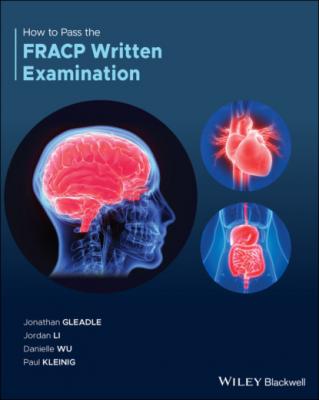How to Pass the FRACP Written Examination. Jonathan Gleadle
Читать онлайн.| Название | How to Pass the FRACP Written Examination |
|---|---|
| Автор произведения | Jonathan Gleadle |
| Жанр | Медицина |
| Серия | |
| Издательство | Медицина |
| Год выпуска | 0 |
| isbn | 9781119599548 |
Recommended volume of fluid resuscitation starts at 30 mL/kg; however, the balance of additional fluids and the use of vasopressors remains uncertain. Several clinical trials are underway which will evaluate this, however currently the goal of fluid resuscitation should be targeted at a mean arterial pressure (MAP) of 65 mmHg through the use of fluids and vasopressors, while normalising the lactate level. Two clinical trials show the potential for harm with starch‐related intravenous fluids, but limited evidence to support the use of colloids over crystalloids. (Starch trial: https://www.nejm.org/doi/full/10.1056/NEJMoa1204242 and ALBIOS trial: https://www.nejm.org/doi/full/10.1056/nejmoa1305727). There is emerging evidence for the use of balanced crystalloid solutions over 0.9% sodium chloride (SMART trial, https://www.nejm.org/doi/full/10.1056/NEJMoa1711584). There is also some emerging evidence for fluids potentially leading to higher mortality (FEAST trial, https://www.nejm.org/doi/full/10.1056/NEJMoa1101549).
In summary:
Septic shock is a medical emergency and resuscitation should begin immediately.
Initial fluid volume administered should start at 30 mL/kg.
Further fluid administration should be based on haemodynamic status as determined by physiologic parameters (BP, HR, urine output, oxygen saturation and temperature).
A target MAP of 65 mmHg may be used for vasopressor and fluid adjustment.
Serial measurement of CVP, Scvo2 and haemoglobin using a CVC is no longer recommended.
Berger R, Rivers E, Levy M. Management of Septic Shock. New England Journal of Medicine. 2017;376(23):2282–2285.
https://www.nejm.org/doi/full/10.1056/NEJMclde1705277?url_ver=Z39.88‐2003&rfr_id=ori:rid:crossref.org&rfr_dat=cr_pub%3dpubmed
Rhodes A, Evans L, Alhazzani W, Levy M, Antonelli M, Ferrer R et al. Surviving Sepsis Campaign: International Guidelines for Management of for Management of Sepsis and Septic Shock: 2016. Critical Care Medicine: 2017; 45: 486–552.https://journals.lww.com/ccmjournal/Fulltext/2017/03000/Surviving_Sepsis_Campaign___International.15.aspx
17. Answer: B
Severe asthma is defined as uncontrolled asthma despite adherence to maximum optimised therapy and treatment of contributing factors or that exacerbates when high‐dose treatment is decreased. Patients with severe asthma suffer a substantial burden of symptoms, exacerbations, and side effects from medications. Patients with comorbidities such as severe sinus disease, recurrent respiratory infections, sleep apnoea, and gastroesophageal reflux experience more frequent recurrent exacerbations of severe asthma.
According to Global Initiative for Asthma (GINA) guidelines, approximately 50% of patients with severe asthma have type 2 inflammation which is characterised by eosinophils, increased fractional inhaled nitric oxide (FeNO), and cytokines such as interleukin [IL]‐4, IL‐5, IL‐13. GINA guidelines do not suggest use of exhaled nitric oxide to guide therapy in patients with severe asthma.
Mepolizumab is a humanised immunoglobulin G1 kappa monoclonal antibody specific for IL‐5. It binds to IL‐5 and stops IL‐5 from binding to its receptor on the surface of eosinophils. Therefore, it reduces blood, tissue, and sputum eosinophil levels. It is indicated for add‐on maintenance treatment of patients with severe asthma and with an eosinophilic phenotype.
Global Initiative for Asthma – Global Initiative for Asthma – GINA [Internet]. Global Initiative for Asthma – GINA. 2020 [cited 7 July 2020]. Available from: http://www.ginasthma.org
18. Answer: D
This patient has clinical evidence of severe and complicated Clostridium difficile infection (CDI). The incidence of CDI continues to rise. Oral vancomycin 125 mg four times daily is recommended as first‐line therapy for severe CDI. It can be administrated via nasogastric tube or per rectum. Oral metronidazole 400 mg three times daily for 10 days is recommended as first‐line therapy for first episode mild CDI. Fidaxomicin, a first‐in‐class macrocyclic bactericidal antibiotic, has targeted bactericidal activity against C. difficile through inhibiting clostridial RNA polymerase. Fidaxomicin demonstrates minimal impact on normal gut flora and spares Bacteroides spp., a major ‘protective’ constituent of faecal flora. Fidaxomicin has minimal oral absorption like vancomycin and a prolonged post‐antibiotic effect and has been approved by the Therapeutic Drug Administration (TGA) for use in CDI. Oral fidaxomicin 200 mg twice daily is a treatment alternative in recurrent CDI. Faecal microbiota transplantation (FMT) is a treatment option alternative in recurrent CDI for appropriately selected patients.
Trubiano J, Cheng A, Korman T, Roder C, Campbell A, May M et al. Australasian Society of Infectious Diseases updated guidelines for the management of Clostridium difficile infection in adults and children in Australia and New Zealand. Internal Medicine Journal. 2016;46(4):479–493.
https://onlinelibrary.wiley.com/doi/epdf/10.1111/imj.13027
19. Answer: B
Sepsis is life‐threatening organ dysfunction caused by an infection‐induced dysregulated host response, which may be complicated by septic shock. Sepsis and septic shock are major causes of morbidity and mortality worldwide. The Surviving Sepsis Campaign (SSC) has strongly emphasised the importance of speed and appropriateness of therapy in improving outcomes. Since the application of the first SSC guidelines, a substantial reduction in mortality has been reported. Both sepsis and septic shock should be viewed as medical emergencies requiring rapid diagnosis and immediate intervention.
The hour‐1 bundle encourages clinicians to act as quickly as possible to obtain blood cultures, administer broad spectrum antibiotics, start appropriate fluid resuscitation, measure lactate, and begin vasopressors if clinically indicated. Ideally these interventions would all begin in the first hour from sepsis recognition but may not necessarily be completed in the first hour.
SSC Hour‐1 Bundle of Care Elements:
Measure lactate level, remeasure lactate if initial lactate is elevated (>2 mmol/L).
Obtain blood cultures before administering antibiotics.
Administer
